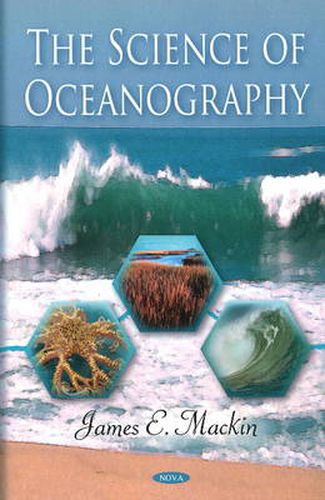Readings Newsletter
Become a Readings Member to make your shopping experience even easier.
Sign in or sign up for free!
You’re not far away from qualifying for FREE standard shipping within Australia
You’ve qualified for FREE standard shipping within Australia
The cart is loading…






The Oceans cover more than 70% of the earth’s surface, and, as such should be expected to have an impact on all life on earth. This book was written from this kind of global perspective. It is intended to give students an appreciation for the impacts of the oceans on their day-to-day lives. from the discussion of the early pioneers of oceanography to the examination of the effects of the oceans on global climate change, the book builds upon the natural excitement that most students have for the oceans. The book also illustrates for students ways that science and mathematics can be used to better understand the oceans. The goal is to transfer the excitement for learning science and mathematics. A Glossary of Terms and several appendices are provided with scientific information that is needed to solve key oceanographic problems. Supplementary materials include PowerPoint presentations of material in all chapters and high-resolution electronic versions of all graphics in the book. The supplementary materials are intended to ease the burden of teaching an introductory oceanography course so that instructors can spend their time on developing effective pedagogues rather than developing instructional materials. The chapters of the book are presented in an order that facilitates student understanding of the major concepts and the linkages between these concepts. Chapter 1 draws the students in to the study of the oceans through an examination of the history of oceanography, including discussion of the roles of famous scientists such as Robert Boyle, Robert Hooke, sir Issac Newton, Galielo Galilei and Johann Kepler. Chapter 2 establishes the framework for oceanographic studies by examining the origin of the oceans. Chapters 3 and 4 then use this information to show how scientists believe the ocean basins have evolved over time to their present state. In chapter 5, the chemistry of the oceans is examined as a necessary prelude to the discussion of atmosphere and ocean circulation in chapters 6 and 7. the examination of physical processes in the oceans continues with discussions of waves and tides in chapters 8 and 9. the tides discussion leads into an examination of near shore environments (estuaries) in chapter 10. Marine organisms are discussed in chapters 11-13, providing the final piece of the oceanography puzzle needed for understanding the trace chemistry of the oceans (chapter 14) and the sources and distributions of marine sediments (chapter 15). All of the oceanographic concepts discussed throughout the book are brought together and integrated through an examination of global climate change in chapter 16.
$9.00 standard shipping within Australia
FREE standard shipping within Australia for orders over $100.00
Express & International shipping calculated at checkout
The Oceans cover more than 70% of the earth’s surface, and, as such should be expected to have an impact on all life on earth. This book was written from this kind of global perspective. It is intended to give students an appreciation for the impacts of the oceans on their day-to-day lives. from the discussion of the early pioneers of oceanography to the examination of the effects of the oceans on global climate change, the book builds upon the natural excitement that most students have for the oceans. The book also illustrates for students ways that science and mathematics can be used to better understand the oceans. The goal is to transfer the excitement for learning science and mathematics. A Glossary of Terms and several appendices are provided with scientific information that is needed to solve key oceanographic problems. Supplementary materials include PowerPoint presentations of material in all chapters and high-resolution electronic versions of all graphics in the book. The supplementary materials are intended to ease the burden of teaching an introductory oceanography course so that instructors can spend their time on developing effective pedagogues rather than developing instructional materials. The chapters of the book are presented in an order that facilitates student understanding of the major concepts and the linkages between these concepts. Chapter 1 draws the students in to the study of the oceans through an examination of the history of oceanography, including discussion of the roles of famous scientists such as Robert Boyle, Robert Hooke, sir Issac Newton, Galielo Galilei and Johann Kepler. Chapter 2 establishes the framework for oceanographic studies by examining the origin of the oceans. Chapters 3 and 4 then use this information to show how scientists believe the ocean basins have evolved over time to their present state. In chapter 5, the chemistry of the oceans is examined as a necessary prelude to the discussion of atmosphere and ocean circulation in chapters 6 and 7. the examination of physical processes in the oceans continues with discussions of waves and tides in chapters 8 and 9. the tides discussion leads into an examination of near shore environments (estuaries) in chapter 10. Marine organisms are discussed in chapters 11-13, providing the final piece of the oceanography puzzle needed for understanding the trace chemistry of the oceans (chapter 14) and the sources and distributions of marine sediments (chapter 15). All of the oceanographic concepts discussed throughout the book are brought together and integrated through an examination of global climate change in chapter 16.